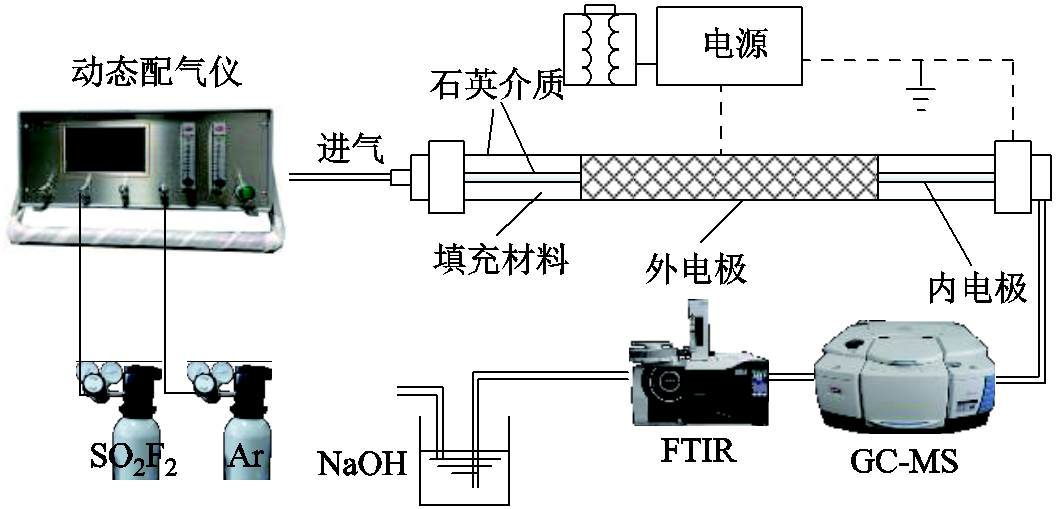
图1 实验平台
Fig.1 Experimental platform
摘要 该文采用介质阻挡放电(DBD)等离子体协同填充材料对SF6降解产物SO2F2进行降解,探究了γ-Al2O3、ZSM-5和玻璃珠在不同输入功率下对SO2F2降解的影响规律。实验发现,填充材料的加入可改善体系的放电情况,增强放电电压和放电电流;填充材料还可有效地提高SO2F2的降解率和能量效率(降解率:玻璃珠>γ-Al2O3>ZSM-5>无填充),改变SO2F2的分解路径和产物选择性,使其生成易于处理的SO2。2%SO2F2在流速为150 mL/min、功率为100 W的情况下,使用玻璃珠填充时SO2F2的降解率和能量效率分别为99.5%和7.69 g/(kW·h),SO2产物含量为9 278.56×10-4%;在同等实验条件下,ZSM-5填充时SO2F2的降解率低于γ-Al2O3和玻璃珠填充,但ZSM-5填充时几乎可使SO2F2定向分解为SO2,产物中SO2的含量可达16 908×10-4%。
关键词:填充材料 介质阻挡放电(DBD) SO2F2降解 降解率 产物选择性
六氟化硫(SF6)是一种无色无味的惰性气体,因其卓越的绝缘性能和灭弧能力被广泛应用于高压电力绝缘领域[1-3]。但SF6是一种强温室效应气体,其温室效应潜在值(Global Warming Potential, GWP)约为CO2的23 500倍,在大气中的寿命为3 200年[4]。随着“双碳”目标的提出,我国推出减污降碳协同增效等一系列相关准则对温室效应气体进行管控[5-6]。对SF6进行降解可极大地减少SF6对大气的危害,然而SF6降解产物多种多样(如SO2F2、SO2、SOF2、H2S等),且均为有毒有害物质,需要采用碱液对其进行吸收转化处理,其中硫酰氟(SO2F2)作为SF6的重要分解产物之一[7],具有较强的温室效应和毒性;此外,SO2F2与碱液反应过程缓慢,很难被碱液完全吸收。因此,对SF6降解产生的SO2F2进行二次降解可完善SF6的无害化处理流程。
目前,国内外针对SO2F2废气的处理方法有碱液处理法[8]、吸附法[9-10]、低温等离子体法[11-12]等。其中低温等离子体法因其结构简单、易于控制、效率高等优点,被广泛应用于固氮、CO2转化、挥发性有机物(Volatile Organic Compounds, VOCs)处理、SF6降解[13-18]等废气处理领域,但产物选择性差是等离子体法存在的共性问题。等离子体技术协同催化剂可极大地改善产物的选择性,同时可在一定程度上提高待降解物的降解率和能量效率。催化剂材料可分为单原子催化剂、金属催化剂、分子筛和金属氧化物等。其中分子筛因其多孔结构、较大比表面积等优点被广泛应用于VOCs降解中[19]。分子筛孔径内大量的吸附位点可使降解分子在等离子体区域内停留更长的时间,近而使降解分子充分分解。王乾浩等[20]探究了不同Si/Al比的ZSM-5分子筛对CO2-H2S重整合成气的影响规律,发现Si/Al比为80的ZSM-5催化剂表现出最优的催化性能,H2和CO的最高产率分别达到56.1%和10.0%。金属氧化物催化剂因其表面晶格氧而表现出强氧化性,晶格氧在低温等离子体的作用下释放出来形成表面活性氧原子,有助于气体氧化降解[21]。本课题组探究了γ-Al2O3、玻璃珠和ZrO2对SF6降解的影响规律[22-24],发现玻璃珠参与下SF6的降解率最高,γ-Al2O3次之,但玻璃珠降解产物中主要为SO2F2,而在γ-Al2O3填充体系下,产物主要为易于处理的SO2,但仍存在大量SO2F2。郑其锋等[25]探究了石英玻璃球对SO2F2脱除效率的影响规律,当放电电压为11.4 kV时,体积分数为0.7%的SO2F2气体经过填充石英玻璃球的等离子体反应器处理后,SO2F2的脱除效率达到100%,降解产物为SO2、SiF4及S,该文主要检测了SO2F2的降解率,对SO2F2的分解产物和分解机理并无详细分析,且对SO2F2的处理效率较低。
为探究对SO2F2降解更优异的填充催化剂材料,本文采用ZSM-5、γ-Al2O3和玻璃珠作为填充催化剂,协同介质阻挡放电(Dielectric Barrier Discharge, DBD)等离子体对SO2F2进行降解,计算不同填充材料下的降解率和能量效率,对降解后主要产物的含量进行检测,并分析各填充材料对SO2F2降解的作用机理。
本文搭建的填充床式DBD实验平台如图1所示,主要包括配气系统、DBD电源及反应系统、尾气检测和处理系统。采用GC500型四通道智能动态配气仪控制输入SO2F2气体体积分数和流速。本文实验中使用的SO2F2气体体积分数为2%,背景气体为Ar,气体总流量为150 mL/min。采用快速傅里叶红外(Fourier Transform Infrared Spectrophotometer, FTIR)光谱分析仪对SO2F2气体分解产物进行定性分析,确定分解产物的种类和变化趋势;使用气相色谱质谱联用仪(Gas Chromatography-Mass Spectrometer, GC-MS)对SO2F2及其主要分解产物SO2、SOF2、SiF4进行定量检测,分析SO2F2的主要分解路径。本文通过李萨如图形法测量DBD的放电功率。

图1 实验平台
Fig.1 Experimental platform
本文采用的γ-Al2O3、ZSM-5和玻璃珠均为直径为2.5 mm的球状颗粒。其中玻璃珠成分为99%SiO2;γ-Al2O3为纯度大于92%的活性Al2O3;ZSM-5组分为[Na+n(H2O)16][AlnSi96-nO192]-MFI(mobile five)。
SO2F2降解率 计算公式为
计算公式为
 (1)
(1)
式中, 为降解前SO2F2体积分数;
为降解前SO2F2体积分数; 为降解反应后SO2F2剩余体积分数。
为降解反应后SO2F2剩余体积分数。
SO2F2的能量效率 (g/(kW·h))定义为单位输入能量下降解SO2F2的质量,计算公式为
(g/(kW·h))定义为单位输入能量下降解SO2F2的质量,计算公式为
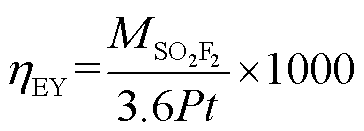 (2)
(2)
式中, 为t时间(h)内降解SO2F2气体的质量,g;P为放电功率,W。
为t时间(h)内降解SO2F2气体的质量,g;P为放电功率,W。
本文首先探究了SF6经过DBD降解后降解产物的含量(体积分数)分布(实验条件:气体组成为2%SF6/ 98%Ar,气体流速为150 mL/min,输入功率为90 W),结果如图2a所示。SF6降解产物中SO2F2和SOF2含量最高,分别为1 153×10-4%、1 080× 10-4%,H2S和SO2含量相对较少。为使SF6无害化排放,需采用碱液对降解后的气体进行处理,本文采用1%NaOH溶液对SF6的降解尾气进行处理,处理后各气体含量如图2b所示。可发现SOF2、H2S、SO2等产物被有效地处理,而SO2F2因性质稳定,不易与碱液反应,经处理后含量仍有889×10-4%,碱液吸收率仅为22.9%,处理效率较低。为实现SF6无害化降解,本文采用等离子体协同催化技术对SF6降解产物SO2F2进行二次降解。首先通过第一级反应器使SF6分解为SO2F2、SOF2、SO2等物质,经过碱液处理后,气体中剩余不易与碱液反应的SO2F2;然后采用等离子体协同催化技术对SO2F2进行二次降解,使其转化为易于处理的SO2;最后碱液处理实现SF6的无害化降解。关于SF6的降解技术已开展了较多研究,本文主要研究针对SO2F2的二次降解。

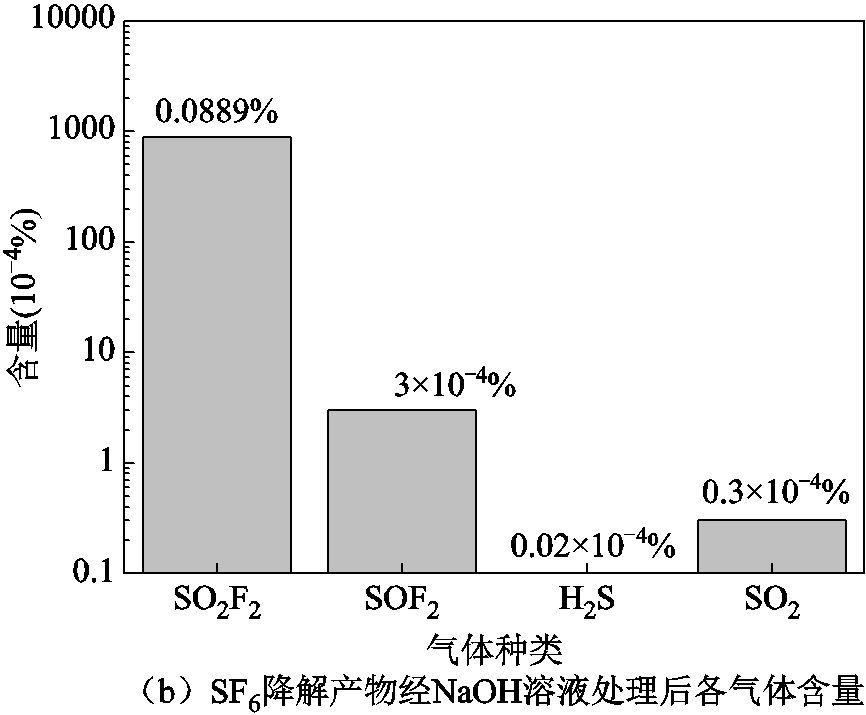
图2 SF6降解产物经碱液处理前后各气体含量
Fig.2 The gas content of SF6 degradation products before and after lye treatment
为了分析不同填充材料下放电体系的放电情况,本文采集了不同填充材料下放电体系的电压和电流。不同填充材料在输入功率为70 W时的电压、电流波形如图3所示。在同一输入功率下,填充材料的加入可有效地提高放电电压和电流,γ-Al2O3和ZSM-5填充体系下的放电电压和电流值较为接近,其中γ-Al2O3填充体系的放电电压和电流分别为11.99 kV、181 mA;填充玻璃珠后反应体系的放电电压和电流值最大,分别为13.59 kV、210 mA。在空管体系下有明显的细丝放电,γ-Al2O3和ZSM-5填充体系下细丝放电显著减少,玻璃珠填充体系下未见明显细丝放电,表明催化剂的加入可改善放电情况,使放电更均匀。
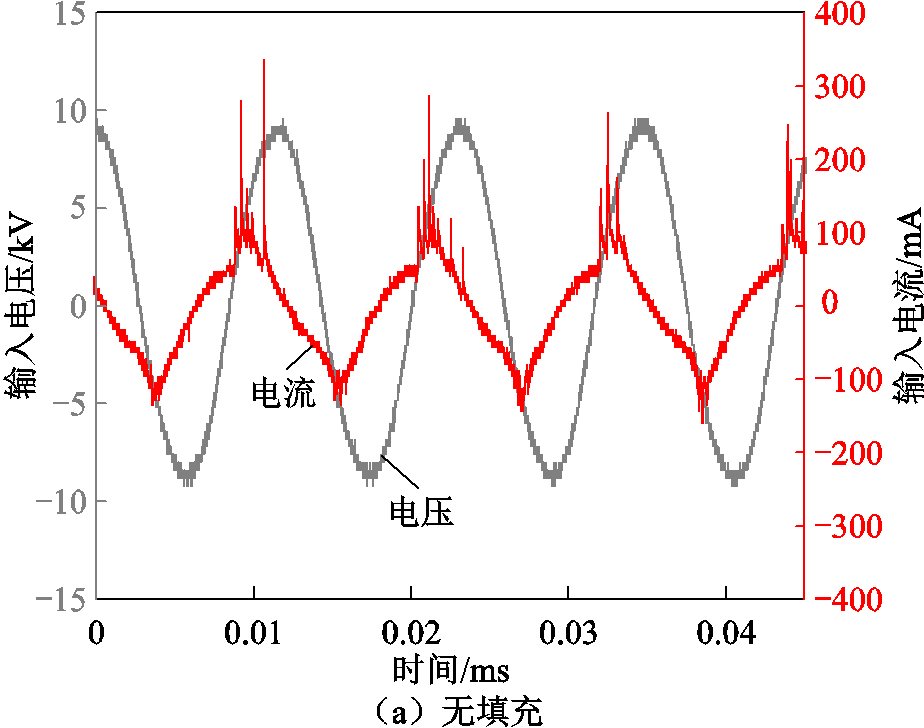

图3 不同填充材料下的电压、电流波形(输入功率70 W)
Fig.3 Waveforms of voltage and current under different filling materials (input power: 70 W)
不同填充材料下放电体系的李萨茹图形如图4所示。填充材料的加入使得放电李萨茹图形从空管体系的平行四边形变得接近椭圆形,同时填充材料加入后李萨茹图形面积增大,表明填充材料加入后单个放电周期内的放电功率增加,从而使更多的能量用于活化分解SO2F2。填充γ-Al2O3和ZSM-5的李萨茹图形面积基本一致,填充玻璃珠的李萨茹图形面积最大,表明在同一输入功率下,填充玻璃珠体系的放电功率最大。不同填充材料体系下绝缘介质等效电容见表1。ZSM-5和玻璃珠填充时放电体系的AB段斜率大于γ-Al2O3,这得益于ZSM-5和玻璃珠具有较高的相对介电常数。ZSM-5和玻璃珠填充时放电体系绝缘介质等效电容分别为82.47 pF和75.54 pF,显著高于空管时的57.63 pF。
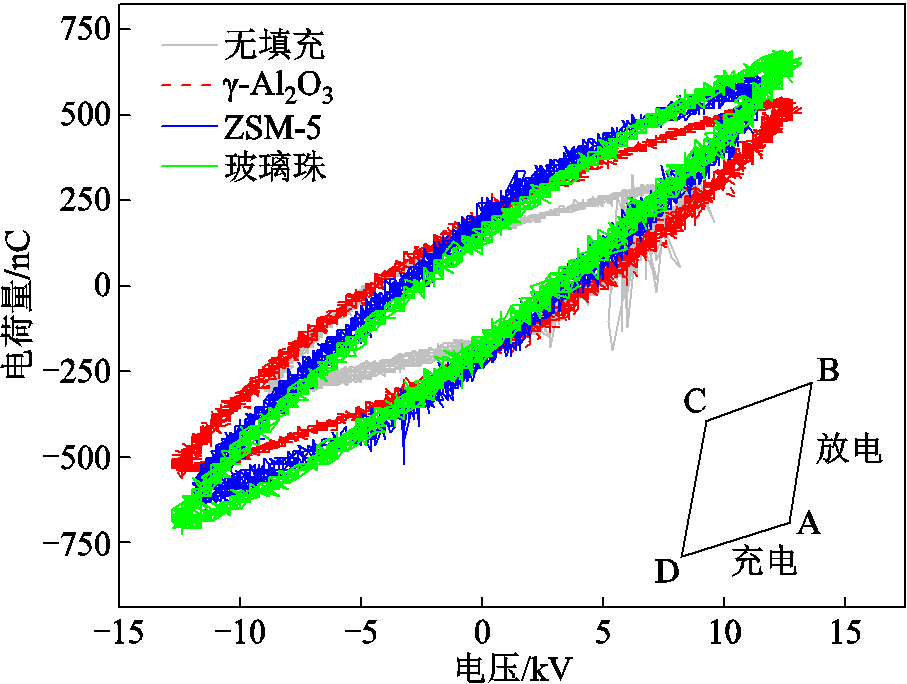
图4 不同填充材料下李萨茹图形
Fig.4 Lissajous figure under different filling materials
表1 不同填充材料体系下绝缘介质等效电容
Tab.1 Equivalent capacitance of insulating dielectric under different filler material systems

填充材料等效电容/pF 空管57.63 γ-Al2O366.55 ZSM-582.47 玻璃珠75.54
不同填充材料下SO2F2的降解率和能量效率如图5所示。由图5可知,随着输入功率的增加,不同填充体系下SO2F2的降解率均逐渐增加;玻璃珠填充体系下的能量效率呈现先增加后降低的趋势,其余体系下SO2F2的能量效率均逐渐下降。这是由于当输入功率由50 W增加到60 W时,玻璃珠体系下SO2F2的降解率显著增加,更多的SO2F2发生降解导致能量效率增加,而随着输入功率继续增加,SO2F2降解率增加缓慢,从而导致能量效率降低;在其他填充材料体系下,随着输入功率的增加,SO2F2降解率均缓慢增加,促使SO2F2能量效率呈现逐渐降低的趋势。

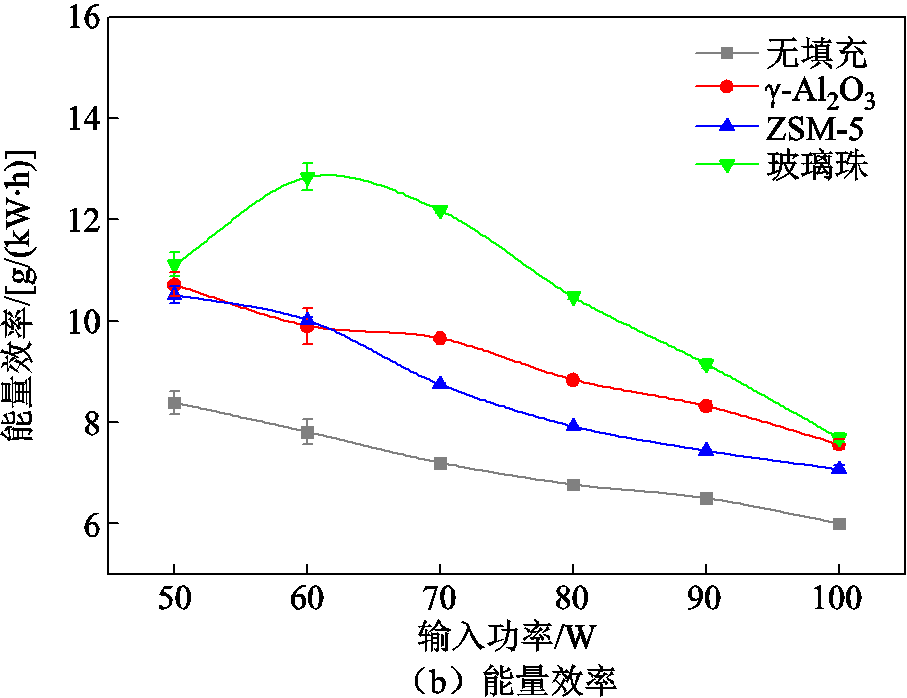
图5 不同填充材料下的降解率和能量效率
Fig.5 Destruction and removal efficiency and energy yield of different filling materials
在输入功率为50~60 W时,γ-Al2O3、ZSM-5和玻璃珠填充时的SO2F2降解率基本一致;而在输入功率为60~80 W时,γ-Al2O3和玻璃珠填充时的降解率显著增加,ZSM-5的降解率缓慢增加。这是由于在低功率时,电子能量密度较低,γ-Al2O3中激发态晶格氧较少,降解率较低,当能量密度增加到γ-Al2O3中的晶格氧阈值时,大量氧原子被激发,从而促进SO2F2分解,使SO2F2降解率快速提升;当功率增加到一定值时,玻璃珠填充体系更容易被击穿放电,增加放电功率进而提高SO2F2降解率;ZSM-5主要通过自身结构的吸附位点对SO2F2进行吸附,并在吸附位点上协同等离子体使其断键分解,分解后的产物在其表面脱吸附,而随着输入功率的增加,吸附位点数量并没有变化,仅放电能量增加,电荷密度增加,进而提高SO2F2降解率。在输入功率为100 W时,玻璃珠填充体系下SO2F2降解率最高,降解率和能量效率分别为99.5%、7.69 g/(kW·h)。可见,填充材料的加入使SO2F2的降解率和能量效率均显著提高。
为了探究SO2F2在不同填充材料下的产物种类,本文采用FTIR对不同填充材料下的降解产物进行分析,结果如图6所示。
SO2F2分解产物有SOF2、SOF4、OF2、SO2等。由图6可知,在四种体系下均出现了SiF4的吸收峰,但在ZSM-5和玻璃珠体系下SiF4的吸收峰强度最强。由于本文实验使用的反应器是SiO2石英玻璃材质,SO2F2解离产生的F-会与SiO2反应生成SiF4,而ZSM-5中也含有SiO2,导致ZSM-5和玻璃珠填充时SiF4吸收峰强度最高;而在空管和γ-Al2O3填充时,仅DBD反应器中的SiO2参与反应,因此SiF4含量相对较少。空管体系下,在945.4 cm-1处还发现了SF6的吸收峰,这是因为SO2F2在断键分解过程中产生的S6+与F-结合生成了结构更为稳定的SF6。而填充其他材料时没有发现SF6的吸收峰,这是因为S6+与F-结合形成SF6的反应是一个可逆反应,在γ-Al2O3填充时,γ-Al2O3中的活性晶格氧被激发并与断键生成的S原子反应生成硫氧化合物,从而抑制SF6的生成;而在ZSM-5和玻璃珠填充时,内部的SiO2在等离子体放电过程中会参与SO2F2的分解反应,阻断S6+与F-离子结合形成SF6。在无填充催化剂体系下,SOF2在750 cm-1处的吸收峰强度较强,1 339 cm-1处的SO2吸收峰较弱;在γ-Al2O3和ZSM-5填充体系下,仅检测到微弱的SOF2吸收峰,而SO2吸收峰强度增强,表明填充γ-Al2O3、ZSM-5和玻璃珠催化剂后可改变SO2F2的分解路径,使其生成更稳定的SO2。
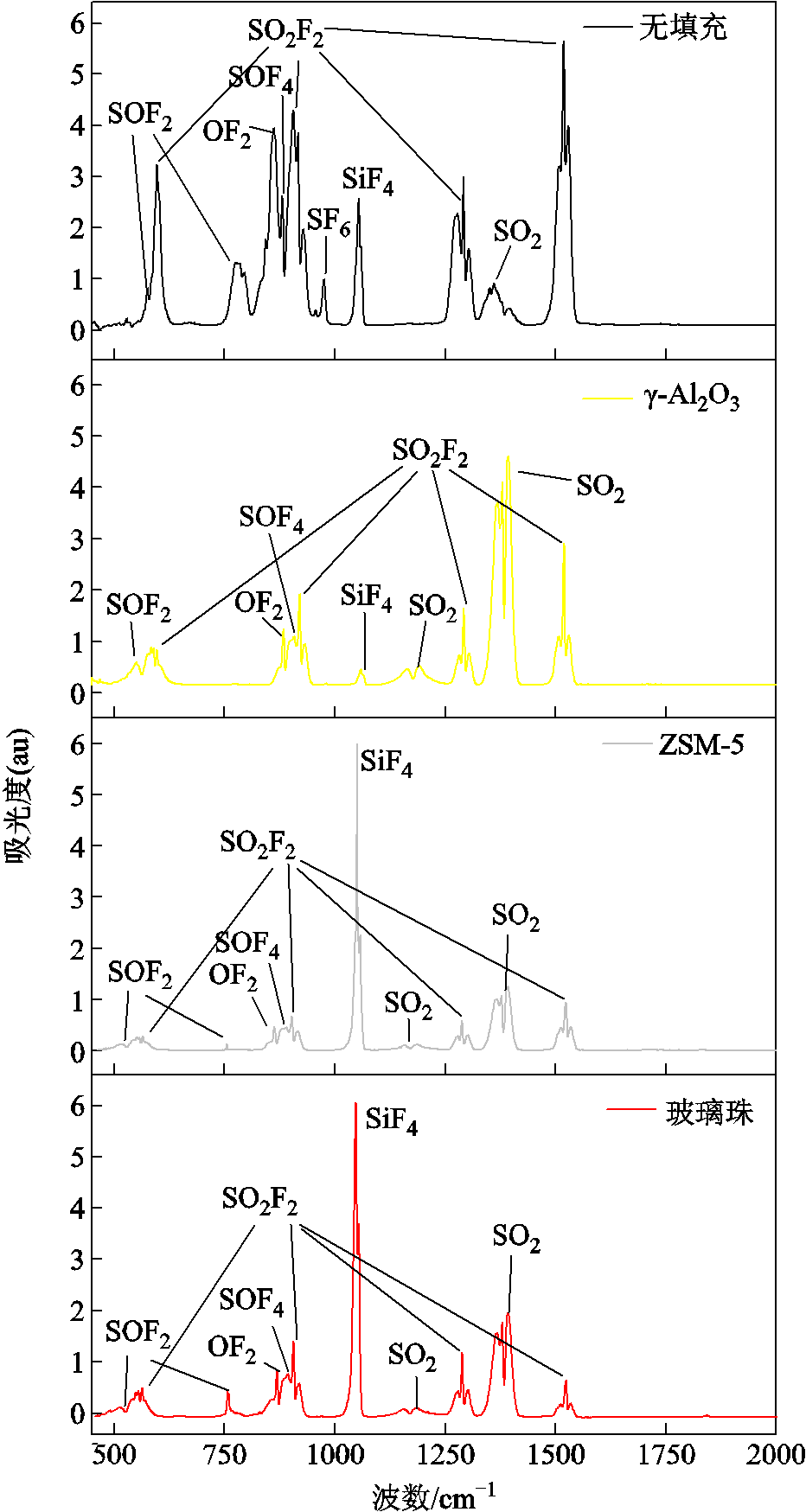
图6 70 W时不同填充材料下降解产物的红外光谱
Fig.6 FTIR spectrum of degradation products of different filling materials at 70 W
为了探究SO2F2分解后各产物的含量,本文采用GC-MS对降解后气体中的SO2、SOF2、SiF4进行定量分析,结果如图7所示;并分析了SO2F2潜在分解过程及其反应势能,见表2。从图7a可知,空管体系下,SO2F2的分解产物中SOF2含量最高,随着输入功率的增加,SO2、SOF2含量均逐渐增加,这是由于随着输入功率的增加,产生了更多高能电子与Ar碰撞激发,大量Ar*和e*与SO2F2碰撞使其激发分解生成SO2和SOF2,促进了反应①、②、③、⑤。而填充γ-Al2O3、ZSM-5和玻璃珠后,分解产物中主要为SO2,这是由于填充材料后,SO2F2分解更充分,反应③中初步分解产物SOF2也分解生成性质更稳定的SO2,促进反应⑤发生,可见填充材料可以改变SO2F2的分解路径。此外SO2F2直接分解为SO2需要-123.779 kcal/mol(1 kcal=4.814 kJ),而SO2F2先分解为SOF2再分解为SO2仅需-88.549 kcal/mol,表明催化剂的加入可降低SO2F2分解的反应势能,改变SO2F2分解路径。在ZSM-5填充体系下,SO2的含量更高,在输入功率为100 W时,SO2含量达到16 908×10-4%,几乎可使SO2F2完全定向分解为SO2,这得益于ZSM-5的多孔结构,ZSM-5可为SO2F2及其分解产物提供更多的吸附位点,使SO2F2在等离子体区域内停留时间更长,从而使得SO2F2分解更充分。玻璃珠填充下主要产物为SO2,且SO2含量随着输入功率的增加而增加。此外,在各填充体系下均检测到大量SiF4。在空管和γ-Al2O3填充体系下,SiF4含量几乎不随着输入功率的变化而变化,且填充γ-Al2O3后SiF4含量低于空管体系。在空管体系下,SiF4含量稳定在2 000×10-4%左右,而γ-Al2O3填充时SiF4含量稳定在1 000×10-4%左右,这是由于空管体系下等离子体反应主要发生在反应器表面,且反应器内的SiO2参与SO2F2分解反应,反应过程为⑥;γ-Al2O3填充时SO2F2的分解反应主要发生在γ-Al2O3表面,而在DBD反应器表面发生的SO2F2分解反应减少,从而使SiF4含量减少;在ZSM-5和玻璃珠填充时,由于ZSM-5和玻璃珠内部的大量SiO2参与SO2F2的分解反应,促进反应⑥进行,从而使SiF4含量显著增加。

图7 不同填充材料下降解产物含量
Fig.7 The content of degradation products decreased with different filling materials
表2 SO2F2分解反应路径及其反应势能[11,26]
Tab.2 The decomposition reaction pathway of SO2F2 and the reaction potential energy[11,26]

编号反应式反应势能/(kcal/mol) ① ② ③-27.2 ④-61.349 ⑤-123.779 ⑥-310.916
玻璃珠填充体系下,SO2F2的降解率最高,但该体系下易于处理的SO2含量较少。综合考虑SO2F2的降解率、能量效率和各产物含量,ZSM-5填充体系下SO2F2的降解效果最优,此时,2%SO2F2/98%Ar在输入功率为100 W、气体流速为150 mL/min的实验条件下,SO2F2的降解率为86.3%,SO2的含量为16 908×10-4%,几乎可使SO2F2定向分解为SO2。
本文通过搭建介质阻挡放电实验平台探究了γ-Al2O3、ZSM-5和玻璃珠对SO2F2降解的影响规律,得到如下结论:
1)填充玻璃珠时,SO2F2的降解率和能量效率最高,γ-Al2O3和ZSM-5次之。在玻璃珠填充体系下,在输入功率为100 W时,SO2F2的降解率和能量效率分别为99.5%和7.69 g/(kW·h)。填充材料的加入可改变放电体系的等效电容,不同材料下介质等效电容大小关系为:ZSM-5>玻璃珠>γ-Al2O3>无填充。
2)在输入功率为70~100 W时,SO2F2在ZSM-5填充体系下更倾向于生成SO2,在功率为100 W时,SO2的含量为16 908×10-4%,SO2F2几乎可定向分解为SO2。同等实验条件下填充γ-Al2O3时SO2含量为14 078.56×10-4%。
3)SO2F2的主要分解产物为SOF2、SO2、SOF4、OF2等,加入催化剂可改变SO2F2的分解路径,使其生成易于处理的SO2。在降解产物中还含有大量SiF4,表明发生了刻蚀反应,其中ZSM-5中的Si元素来自SO2F2分解反应。
参考文献
[1] 张国治, 胡栩焜, 邓广宇, 等. SF6及SF6故障分解气体与局部放电柔性特高频天线传感器基底相容性实验研究[J]. 电工技术学报, 2023, 38(15): 4050-4062. Zhang Guozhi, Hu Xukun, Deng Guangyu, et al. Experimental study on substrate compatibility of SF6and SF6 fault-decomposing gases with partial dischargeflexible UHF antenna sensors[J]. Transactions of China Electrotechnical Society, 2023, 38(15): 4050-4062.
[2] 蒋庆明,张艳妹,王明祥,等. SF6分解组分的气体传感器检测方法综述[J].绝缘材料, 2024, 57(3): 1-14. Jiang Qingming, Zhang Yanmei, Wang Mingxiang, et al. Review of gas sensor detection methods for SF6 decomposition components[J]. Insulating Materials, 2024, 57(3): 1-14.
[3] 李昊天, 曾福平, 颜伊鸣, 等. Ag表面对SF6初级分解产物氧化反应的影响作用研究[J]. 电工技术学报, 2024, 39(9): 2841-2850. Li Haotian, Zeng Fuping, Yan Yiming, et al. Study on the effect of Ag surface on oxidation of SF6 primary decomposition products[J]. Transactions of China Electrotechnical Society, 2024, 39(9): 2841-2850.
[4] Sulbaek Andersen M P, Kyte M, Andersen S T, et al. Atmospheric chemistry of (CF3)2CF—C≡N: a replacement compound for the most potent industrial greenhouse gas, SF6[J]. Environmental Science & Technology, 2017, 51(3): 1321-1329.
[5] Zhang Dongzhi, Sun Yan’e, Li Peng, et al. Facile fabrication of MoS2-modified SnO2 hybrid nanocomposite for ultrasensitive humidity sensing[J]. ACS Applied Materials & Interfaces, 2016, 8(22): 14142-14149.
[6] 向柳, 陈明扬, 文新茹. 面向“双碳”目标的温室气体排放数据体系建设路径研究[J]. 统计与咨询, 2023(2): 16-18.
[7] 张晓星, 周畅, 崔兆仑, 等. 填充颗粒尺寸对介质阻挡放电降解SF6的影响[J]. 电工技术学报, 2022, 37(18): 4766-4776. Zhang Xiaoxing, Zhou Chang, Cui Zhaolun, et al. Effect of particle size on degradation of SF6 by dielectric barrier discharge[J]. Transactions of China Electrotechnical Society, 2022, 37(18): 4766-4776.
[8] Nie Yong, Liang Xiaojiang, Ji Jianbing, et al. Harmless treatment of sulfuryl fluoride by chemical absorption [J]. Environmental Engineering Science, 2015, 32(9): 789-795.
[9] 曹国洲, 华正江, 朱晓艳, 等. 一种硫酰氟的消除方法: CN104324704B[P]. 2016-08-17.
[10] 张竹娇. 硫酰氟在生物基溶剂中的溶解特性研究[D]. 杭州: 浙江工业大学, 2020.Zhang Zhujiao. Study on the dissolution characteristics of sulfuryl fluoride in bio-based solvents[D]. Hangzhou: Zhejiang University of Technology, 2020.
[11] 张国治, 王文祥, 张磊, 等. 介质阻挡放电等离子体处理变压器废弃绝缘油的实验探究[J]. 电工技术学报, 2025, 40(1): 325-334. Zhang Guozhi, Wang Wenxiang, Zhang Lei, et al. Experimental exploration of dielectric barrier discharge plasma treatment of transformer waste insulating oil[J]. Transactions of China Electrotechnical Society, 2025, 40(1): 325-334.
[12] 孙闵杰, 付军辉, 刘泓麟, 等. 分段电极介质阻挡放电CO2重整CH4过程放电特性与反应性能研究[J]. 电工技术学报, 2023, 38(15): 3972-3983. Sun Minjie, Fu Junhui, Liu Honglin, et al. Discharge characteristics and reaction performance of CH4 reforming with CO2 in dielectric barrier discharge with segmented electrodes[J]. Transactions of China Electrotechnical Society, 2023, 38(15): 3972-3983.
[13] Xia Ying, Yang Xin, Chang Lei, et al. Development of a compact helicon plasma source with two sets of ring array permanent magnets for the study of blue core plasma[J]. Review of Scientific Instruments, 2023, 94(12): 125110.
[14] 商克峰, 曹无敌, 符梦辑. 电极结构对多孔陶瓷孔内微放电特性及苯降解的影响[J]. 电工技术学报, 2023, 38(6): 1687-1694.Shang Kefeng, Cao Wudi, Fu Mengji. Effect of electrode configuration on microdischarge characteristics in porous ceramics and benzene degradation[J]. Transactions of China Electrotechnical Society, 2023, 38(6): 1687-1694.
[15] Yang Zhaodi, Li Yalong, Wang Yufei, et al. Experimental study on the effect of H2 on the degradation of SF6 by pulsed dielectric barrier discharge[J]. IEEE Transactions on Dielectrics and Electrical Insulation, 2024, 31(1): 448-456.
[16] Wu Yunjian, Gao Peng, Li Yalong, et al. Degradation of SF6 by dielectric barrier discharge cooperating with TiO2 photocatalysis: insights into the reaction mechanism[J]. Applied Surface Science, 2024, 660: 159957.
[17] 方文睿, 唐雄民, 江天鸿, 等. 脉冲激励下介质阻挡放电负载的特性研究[J]. 高压电器, 2024, 60(5): 171-178, 188. Fang Wenrui, Tang Xiongmin, Jiang Tianhong, et al. Research on characteristics of dielectric barrier discharge load under pulse excitation[J]. High Voltage Apparatus, 2024, 60(5): 171-178, 188.
[18] 卢洪伟, 倪志娇, 查学军. 不同电极结构对DBD降解亚甲基蓝废水的影响[J]. 高压电器, 2023, 59(4): 62-69. Lu Hongwei, Ni Zhijiao, Zha Xuejun. Effect of different electrode structures on degradation of methylene blue wastewater by DBD plasma[J]. High Voltage Apparatus, 2023, 59(4): 62-69.
[19] Xu Yaxuan, Chen Xiaozhou, Qiao Congzhen, et al. Dynamics-driven tailoring of Zr-embedded hierarchical ZSM-5 zeolites for enhanced catalytic performance from furfural to alkyl levulinate[J]. Chemical Engin-eering Journal, 2024, 486: 150350.
[20] 王乾浩, 赵璐, 孙付琳, 等. ZSM-5催化剂与低温等离子体协同转化H2S-CO2制合成气[J]. 化工学报, 2022, 73(1): 255-265. Wang Qianhao, Zhao Lu, Sun Fulin, et al. Production of syngas derived from H2S-CO2 via synergy of ZSM-5 catalyst and non-thermal plasma[J]. CIESC Journal, 2022, 73(1): 255-265.
[21] Plota-Pietrzak A, Masek A. Functionalized metal oxide particles with antioxidant as new carriers providing higher stability of polyolefin products[J]. Sustainable Materials and Technologies, 2024, 40: e00885.
[22] Li Yalong, Wan Kun, Wang Yufei, et al. Experimental study on the effect of H2O and O2 on the degradation of SF6 by pulsed dielectric barrier discharge[J]. Plasma Science and Technology, 2024, 26(2): 025506.
[23] Cui Zhaolun, Zhou Chang, Jafarzadeh A, et al. SF6 catalytic degradation in a γ-Al2O3 packed bed plasma system: a combined experimental and theoretical study[J]. High Voltage, 2022, 7(6): 1048-1058.
[24] Zhou Chang, Wang Yufei, Zhang Guozhi, et al. Experimental study on SF6 degradation by dielectric barrier discharge filled with zirconia[C]//The Proceedings of the 16th Annual Conference of China Electrotechnical Society, Beijing, China, 2021: 74-85.
[25] 郑其锋, 聂勇, 顾大勇, 等. 填充式介质阻挡放电等离子体脱除硫酰氟的研究[J]. 高电压技术, 2012, 38(5): 1157-1162. Zheng Qifeng, Nie Yong, Gu Dayong, et al. Removal of SO2F2 by the packed bed dielectric barrier discharge plasma[J]. High Voltage Engineering, 2012, 38(5): 1157-1162.
[26] Cui Zhaolun, Zhang Xiaoxing, Tian Yuan, et al. Effects of glass beads packing on SF6 abatement by packed bed plasma[J]. Plasma Chemistry and Plasma Processing, 2020, 40(1): 43-59.
Abstract Sulfur hexafluoride (SF6), which has strong electronegativity and self-recovery, exhibits excellent insulation and arc-extinguishing capabilities and is widely used in the field of power insulation. However, SF6 is a strong greenhouse effect gas, and its global warming potential is 23 500 times that of CO2, and its degradation can significantly reduce the pollution and harm of SF6 to the atmosphere. Then, there are many kinds of toxic and harmful substances in SF6 degradation products, among which sulfuryl fluoride (SO2F2), as the main decomposition product of SF6, still has the greenhouse effect and huge toxicity and stable nature. The degradation of SO2F2 can improve the harmless degradation process of SF6 and realize the harmless emission of SF6. At present, many scholars at home and abroad for the treatment of SO2F2 waste gas treatment methods mainly include the alkali treatment method, adsorption method, Non-temperature plasma method, etc., in which the Non-temperature plasma method has the advantages of simple structure, ease of control, high efficiency, etc. Still, there is a problem of poor regulation of the product. By filling the catalyst, the degradation rate can be increased and the product selectivity can be improved. In this paper, the degradation of SO2F2 by dielectric barrier discharge (DBD) plasma synergistic filling materials was investigated, and the effects of γ-Al2O3, ZSM-5, and glass beads on the degradation of SO2F2 with different input powers were investigated.
The experimental platform for SO2F2 degradation by DBD plasma synergistic filler materials was first constructed. GC-MS was used to quantify SO2F2 and its degradation products, and the SO2F2 degradation rate and product content were calculated and detected. The experiments found that the addition of filling materials can improve the discharge conditions of the system, enhancing discharge voltage and current. Furthermore, the filling materials can effectively improve the SO2F2 degradation rate and energy efficiency (degradation rate: glass beads>γ-Al2O3>ZSM-5>no filler), and also change the decomposition path and product selectivity of SO2F2 to produce SO2 that is easy to handle. 2% SO2F2 at a flow rate of 150 mL/min and a power of 100 W. As the input power increases, the degradation rate of SO2F2 gradually rises, while the energy efficiency shows an overall decreasing trend. With the filling of glass beads, the degradation rate and energy efficiency of SO2F2 were 99.5% and 7.69 g/(kW·h), respectively, and the concentration of SO2 product was 9 278.56×10-4%, under the same experimental conditions, the degradation rate of SO2F2 was lower than that of γ-Al2O3 and glass bead filling when ZSM-5 was filled, but the ZSM-5 filling could make SO2F2 decompose completely and directionally to SO2, at which time the content of SO2 The SO2F2 decomposition products are mainly SO2, SOF2, SOF4 and SiF4, etc. The results of the study show that the SO2F2 degradation rate is lower than that of γ-Al2O3 and γ-Al2O3 filling, but ZSM-5 filling can almost completely directional decomposition of SO2F2 to SO2, at which time the content of SO2 is 16 908×10-4%. The results of the study provide reference solutions for the efficient degradation of SO2F2 and the harmless treatment of SF6. The main decomposition products of SO2F2 include SOF2, SO2, SOF4, and OF2. The addition of a catalyst can alter the decomposition pathway of SO2F2, facilitating the generation of the more manageable SO2. The degradation products also contain a significant amount of SiF4, indicating that etching reactions have occurred.
keywords:Filling material, dielectric barrier discharge (DBD), degradation of SO2F2, degradation rate, product selectivity
DOI: 10.19595/j.cnki.1000-6753.tces.241116
中图分类号:TM206
国家自然科学基金(52307170)、国家自然科学基金联合基金(U24B2096)、湖北省自然科学基金(2023AFB382)和贵州省科技支撑项目(黔科合支撑[2022]一般207)资助。
收稿日期 2024-06-27
改稿日期 2024-07-22
李亚龙 男,1989年生,博士,讲师,研究方向为气体放电等离子体和环保绝缘气体应用。E-mail:liyalong@hbut.edu.cn
张晓星 男,1972年生,教授,博士生导师,研究方向为电气设备在线检测与故障诊断、绝缘状态评估、SF6替代气体及气体放电等离子体等应用。E-mail:xiaoxing.zhang@outlook.com(通信作者)
(编辑 李 冰)